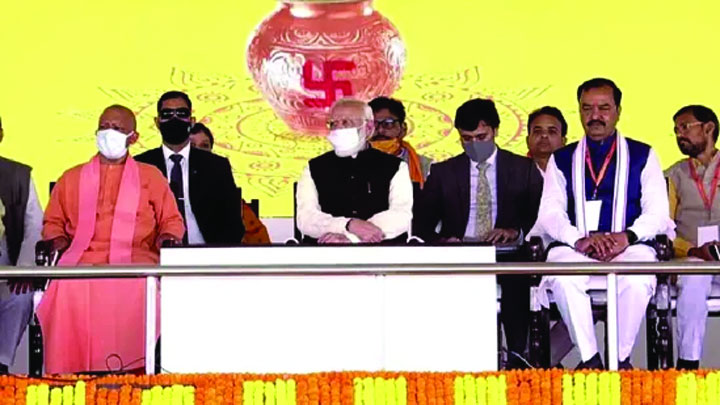Steering the country is not easy. It is true that international organisations are cautious while the Government feels that its efforts are being stymied
India joins the world aiming for a super growth on a high debt and infra push for an economic panacea.
India’s heavy investment over Rs 233.08 lakh crore investment in infrastructure, including Rs 10,500-crore Jewar airport adjacent to Delhi, is officially expected to give a major boost to the economy.
India is not alone. The entire world is trying to do that. The result is hyper-growth in world debt to $226 trillion. In its 2021 Fiscal Monitor report, the IMF said India’s debt increased from 68.9 per cent of its GDP in 2016 to 89.6 per cent in 2020. It is projected to jump to 90.6 per cent in 2021 and then decline to 88.8 per cent in 2022, to gradually reach 85.2 per cent in 2026.
Jewar has accelerated a process of development in UP with an eye on the state elections. It may make this part of the National Capital Region one of the most crowded places inviting large number of migrants that may stretch local resources.
The severe crash in the stock market has added a new concern. The nation hopes to fly on expectations but airport projects, high altitude Himalayan development, large-scale tree felling and acquisition of farm lands raise ecological concerns. But a nation striving hard to come out of the Coronavirus pandemic is looking for faster development so that there is cash flow.
The Government expanded the ‘National Infrastructure Pipeline (NIP)’ to 7,400 projects. According to Department of Industry and internal Trade, 217 projects worth Rs. 1.10 lakh crore ($ 15.09 billion) were completed as of 2020. Through the NIP, the government invested $ 1.4 trillion in infrastructure development as of July 2021.
However, the more investment is made in infrastructure, the more the nation’s cost to deliver. Unless there is an overall growth in activities — from industry to agriculture — the benefits become expensive to afford.
The IMF says that constraints on financing are particularly severe for poorer countries. Noting that in 2020, fiscal policy proved its worth, IMF director for fiscal affairs Vitor Gasper says the increase in public debt in 2020 was fully justified by the need to respond to COVID-19 and its economic, social, and financial consequences. But the increase is expected to be one-off, he said. So how to bring down the debt is the question. Debt dynamics are driven by a strong contribution from nominal GDP growth, accompanied by a much more gradual reduction in the primary deficit, he said.
The IMF said risks to the fiscal outlook are elevated. This calls for India to review its policies. Let us not forget that the 2007-08 global meltdown followed an unsustainable financial behaviour.
The results would be high inflationary tendencies that would add to costs further and create an unstable global economy leading to more conflicts. India’s inflation has risen to 12.5 per cent. Prices are rising, wages too would be rising and a cycle of inflation may continue.
This is also being seen in a regime of high taxations and high penalties on cars and car uses across the country. The silliest is the clampdown on outside state registered vehicles in Bihar, and HSRP plates. These are ignored as small issues but these small things are making lives of people difficult. User charges are being recklessly increased. At some private railway stations, parking charges are going through the roof. Ostensibly, nobody can be blamed as ‘the prices are rising’ but that needs a holistic review.
The IMF projects growth at 9.5 per cent in FY2021-22 and 8.5 per cent in FY2022-23. Headline inflation sees elevated price pressures. The contraction in economic activity, lower revenue, and pandemic-related support measures are estimated to have led to a widening of the fiscal deficit to 8.6 and 12.8 per cent of GDP in FY2020-21 for the central and state governments, respectively.
But the IMF is concerned that despite policy support, bank credit growth has remained subdued, while large corporates have benefited from easier conditions in capital markets. Net inflows and improvement in the current account have supported an increase in foreign exchange reserves. The current account balance is projected to remain in deficit as oil prices rise.
The overall toned down IMF report indicates not an easy situation in the coming years.
Steering the country is not easy. It is true that international organisations are cautious while the government feels that their efforts are being stymied. India hopes that Prime Minister Narendra Modi’s efforts belie the IMF and infra push takes the country to the targeted growth.
(The writer is a senior journalist. The views expressed are personal.)


























